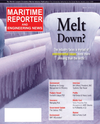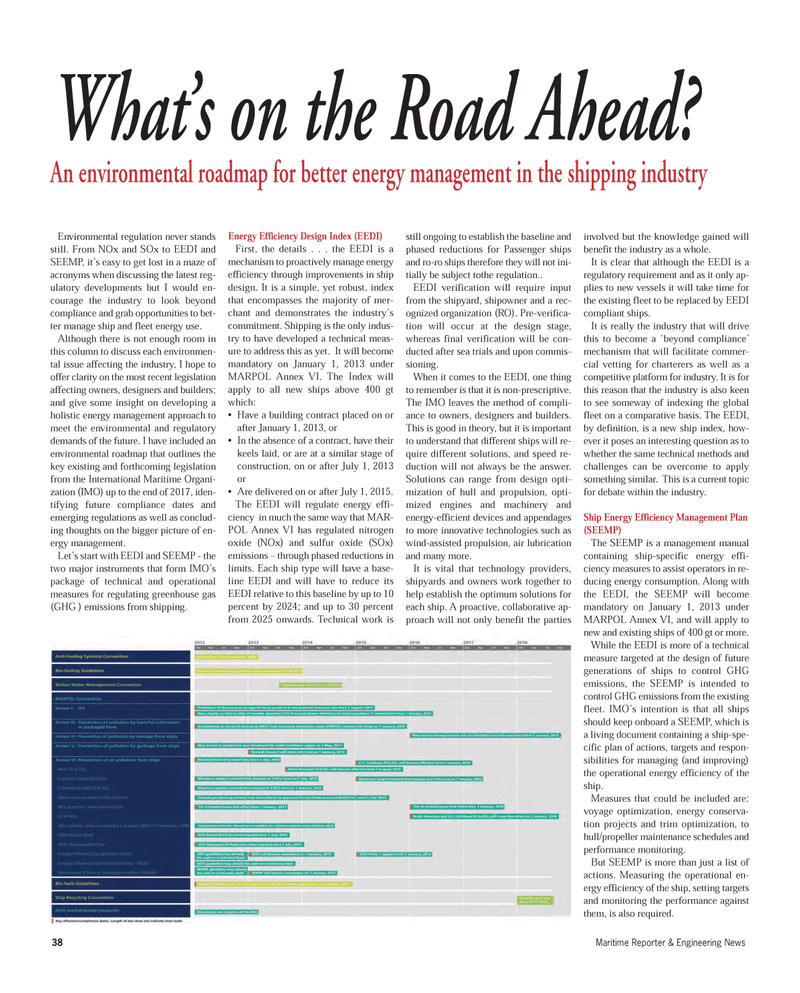
Page 38: of Maritime Reporter Magazine (May 2012)
The Green Ship Edition
Read this page in Pdf, Flash or Html5 edition of May 2012 Maritime Reporter Magazine
Environmental regulation never stands still. From NOx and SOx to EEDI andSEEMP, it?s easy to get lost in a maze of acronyms when discussing the latest reg- ulatory developments but I would en- courage the industry to look beyond compliance and grab opportunities to bet-ter manage ship and fleet energy use. Although there is not enough room inthis column to discuss each environmen- tal issue affecting the industry, I hope to offer clarity on the most recent legislation affecting owners, designers and builders; and give some insight on developing a holistic energy management approach to meet the environmental and regulatory demands of the future. I have included an environmental roadmap that outlines the key existing and forthcoming legislation from the International Maritime Organi- zation (IMO) up to the end of 2017, iden-tifying future compliance dates andemerging regulations as well as conclud- ing thoughts on the bigger picture of en-ergy management. Let?s start with EEDI and SEEMP - the two major instruments that form IMO?s package of technical and operationalmeasures for regulating greenhouse gas (GHG ) emissions from shipping. Energy Efficiency Design Index (EEDI) First, the details . . . the EEDI is amechanism to proactively manage energy efficiency through improvements in ship design. It is a simple, yet robust, index that encompasses the majority of mer- chant and demonstrates the industry?s commitment. Shipping is the only indus-try to have developed a technical meas- ure to address this as yet. It will becomemandatory on January 1, 2013 underMARPOL Annex VI. The Index will apply to all new ships above 400 gt which:Have a building contract placed on or after January 1, 2013, or In the absence of a contract, have their keels laid, or are at a similar stage of construction, on or after July 1, 2013or Are delivered on or after July 1, 2015. The EEDI will regulate energy effi- ciency in much the same way that MAR- POL Annex VI has regulated nitrogen oxide (NOx) and sulfur oxide (SOx)emissions ? through phased reductions inlimits. Each ship type will have a base- line EEDI and will have to reduce its EEDI relative to this baseline by up to 10 percent by 2024; and up to 30 percentfrom 2025 onwards. Technical work is still ongoing to establish the baseline andphased reductions for Passenger ships and ro-ro ships therefore they will not ini- tially be subject tothe regulation.. EEDI verification will require input from the shipyard, shipowner and a rec- ognized organization (RO). Pre-verifica- tion will occur at the design stage,whereas final verification will be con- ducted after sea trials and upon commis-sioning. When it comes to the EEDI, one thingto remember is that it is non-prescriptive. The IMO leaves the method of compli- ance to owners, designers and builders. This is good in theory, but it is important to understand that different ships will re- quire different solutions, and speed re- duction will not always be the answer. Solutions can range from design opti-mization of hull and propulsion, opti-mized engines and machinery andenergy-efficient devices and appendages to more innovative technologies such as wind-assisted propulsion, air lubricationand many more. It is vital that technology providers, shipyards and owners work together to help establish the optimum solutions foreach ship. A proactive, collaborative ap- proach will not only benefit the parties involved but the knowledge gained will benefit the industry as a whole. It is clear that although the EEDI is aregulatory requirement and as it only ap- plies to new vessels it will take time for the existing fleet to be replaced by EEDI compliant ships.It is really the industry that will drive this to become a ?beyond compliance? mechanism that will facilitate commer- cial vetting for charterers as well as a competitive platform for industry. It is for this reason that the industry is also keen to see someway of indexing the global fleet on a comparative basis. The EEDI, by definition, is a new ship index, how- ever it poses an interesting question as to whether the same technical methods andchallenges can be overcome to apply something similar. This is a current topic for debate within the industry. Ship Energy Efficiency Management Plan (SEEMP) The SEEMP is a management manualcontaining ship-specific energy effi- ciency measures to assist operators in re- ducing energy consumption. Along with the EEDI, the SEEMP will becomemandatory on January 1, 2013 underMARPOL Annex VI, and will apply to new and existing ships of 400 gt or more. While the EEDI is more of a technicalmeasure targeted at the design of future generations of ships to control GHGemissions, the SEEMP is intended tocontrol GHG emissions from the existing fleet. IMO?s intention is that all ships should keep onboard a SEEMP, which is a living document containing a ship-spe- cific plan of actions, targets and respon- sibilities for managing (and improving) the operational energy efficiency of the ship. Measures that could be included are:voyage optimization, energy conserva- tion projects and trim optimization, tohull/propeller maintenance schedules andperformance monitoring.But SEEMP is more than just a list ofactions. Measuring the operational en-ergy efficiency of the ship, setting targets and monitoring the performance against them, is also required. 38Maritime Reporter & Engineering News What?s on the Road Ahead? An environmental roadmap for better energy management in the shipping industry MR May 12 # 5 (34-41):MR Template 5/7/2012 2:47 PM Page 38

 37
37

 39
39
